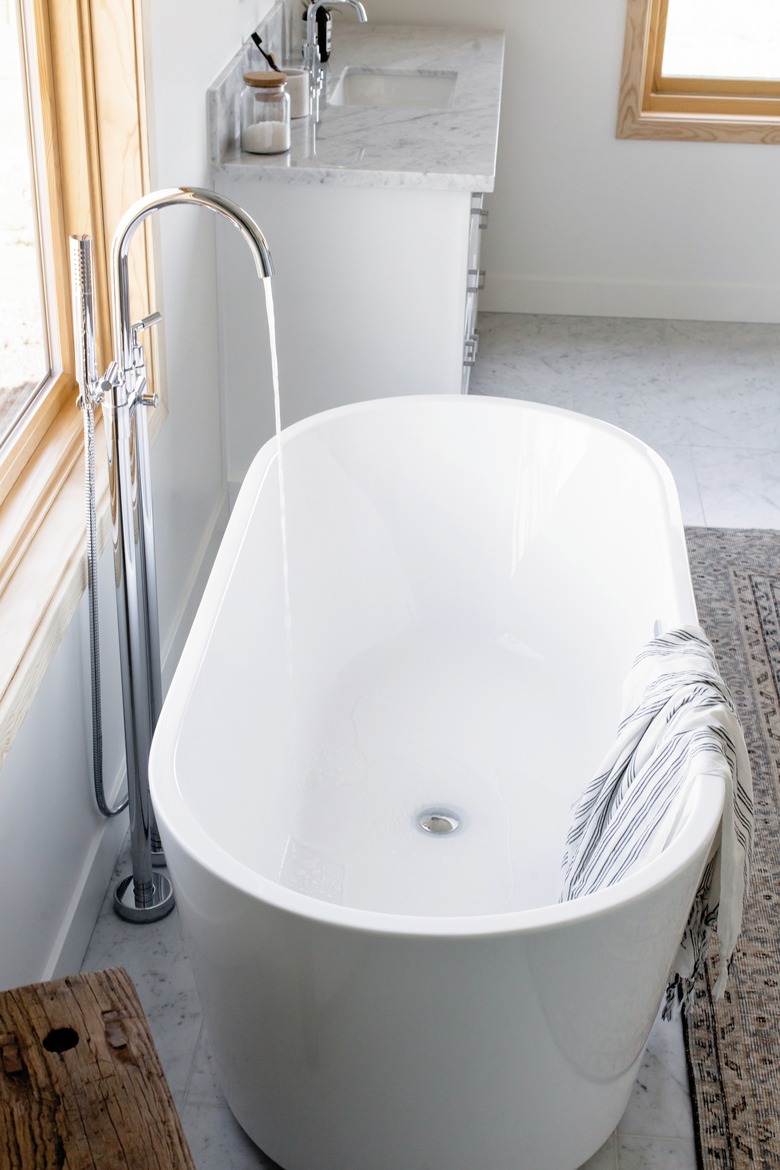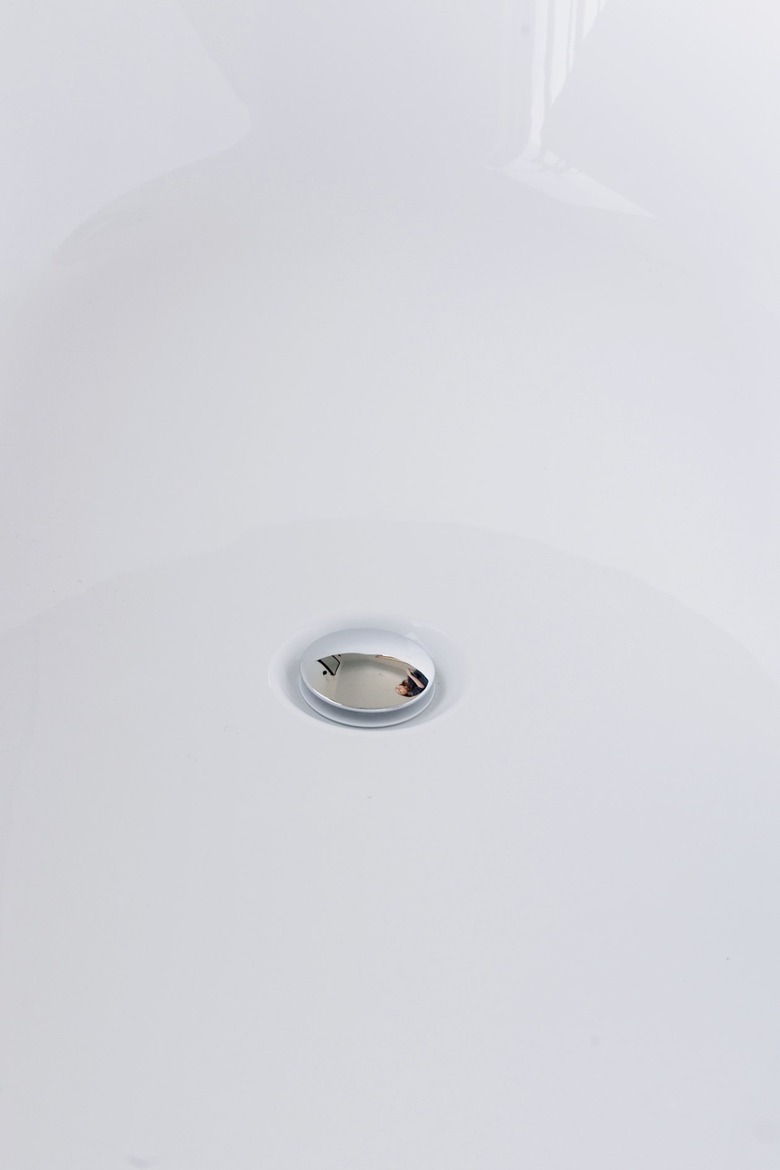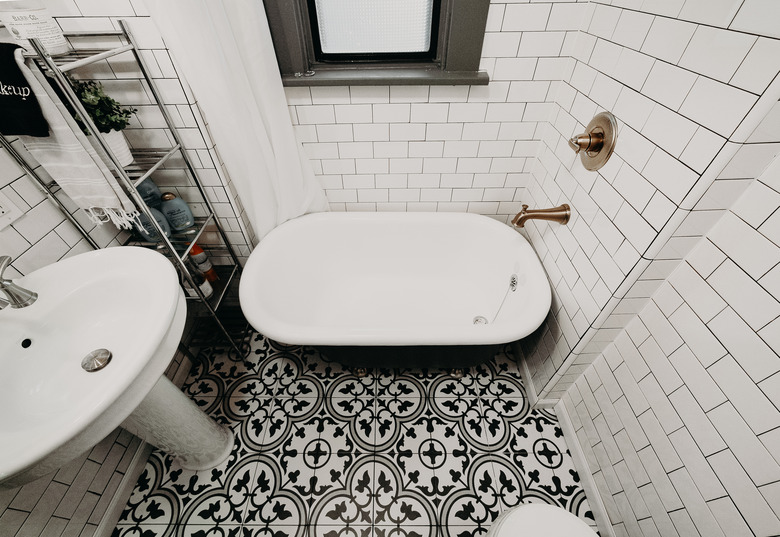How To Remove And Replace A Bathtub Drain
If you don't like your bathtub drain, replacing it is about a five-minute DIY task. That seems like a bold statement considering that most of the drain is under the bathtub, and if you were talking about the entire drain assembly, it wouldn't be true even if you're a plumber. What makes the statement true is that when referring to the bathtub drain, most people are talking about the part that is visible on the bottom of the tub, which is more correctly called the bathtub drain flange. To replace it, you just unscrew the old one and screw in a new one.
Because it's exposed, the bathtub drain flange gets stained and corroded over the years, and it can even start to leak, which are all motivations for replacing it. What's more, if the stopper mechanism stops working, installing a new one usually involves replacing the flange unless the tub has a trip lever, in which case you can extract the entire stopper mechanism and install a new one without removing the flange. If you want to replace a trip-lever mechanism with a different type of stopper, however, you usually need a new bathtub drain flange.
The Bathtub Drain Explained
Most of the bathtub drain is hidden underneath the floor and behind the tub wall, and you usually have to remove some drywall or floorboards to access it. Thankfully, you seldom have to do this, but if you ever do, you'll find the following parts:
- The overflow pipe, which extends vertically from the overflow plate on the wall of the tub to a tee located a few inches beneath the bottom of the tub.
- The P-trap, which is located just past the downward vertical outlet of the tee. On the other end of the trap, a horizontal length of drain pipe connects the tub drain with the waste system.
- The drain shoe, which is a length of horizontal drain pipe that extends from the tee to the bathtub's drain opening. This fitting has an elbow with female threads on the end that receive the male-threaded end of the drain flange, which is the only part of the drain assembly that's visible and easily accessible.
If your tub has a trip lever in the place where the overflow plate usually goes, it operates either a pop-up stopper or an internal stopper. A linkage runs inside the overflow pipe to the tee, and on the end of the linkage is either a weighted metal cylinder that blocks the drain when the lever is up or a spring that operates a rocker arm that in turn operates a pop-up stopper. You can extract the linkage by removing the trip-lever plate, and you can pull the rocker arm directly out of the drain opening.
Types of Bathtub Drain Stoppers
If you don't like your present drain stopper, replacing your bathtub drain flange presents a golden opportunity to change it. Some stoppers screw into a threaded opening in the middle of the flange crossbar, and some work without a crossbar. In most cases, the stopper comes with its own flange. Some popular alternatives to trip-lever stoppers include:
- Toe-touch stoppers, which feature a spring-loaded mechanism that you activate with your foot.
- Lift-and-turn stoppers that are fully removable, which makes it easy to clear the drain and use a snake or plunger to clear clogs.
- Flip-it stoppers that feature a rotating disk with a gasket that stops the water when the disk is horizontal. The version of this stopper sold by Watco, a leading plumbing parts manufacturer, is called the PressFlo bathtub drain stopper.
You'll find these and other types of stoppers featured on plumbing sites such as Badeloft. Keep in mind that if you like your lever-activated stopper, there's no reason you can't keep it if you have to replace a corroded drain flange. Just be sure to get a flange that's compatible with your stopper system.
Things Needed
-
New drain flange
-
Plumbers' putty
-
Drain key or smart dumbbell
-
Screwdriver
-
Wrench
-
Putty knife
-
Damp rag
How to Remove and Replace a Bathtub Drain Flange
1. Get the Right Tool
Purchase a drain key or a smart dumbbell from a plumbing supply outlet. These tools work in slightly different ways, but both make the job of unscrewing the drain flange easier than trying to tap it with a hammer and screwdriver and safer than cutting it with a chisel or hacksaw.
Use a smart dumbbell if both the old and new drain flanges have crossbars onto which its tines can lock. If one or both of the drain flanges lack a crossbar, you're better off with a drain key, which works by wedging itself against the sides of the drain flange.
2. Unscrew the Drain Flange From the Drain Shoe
Insert the end of the smart dumbbell that best fits the flange into the drain opening and orient it so that the tines fit between the crossbars and hook onto them. Insert a screwdriver through the holes in the sides of the key and use it as a lever to turn the flange counterclockwise. Keep turning until the flange comes loose and you can remove it.
If you're using a drain key, insert it in the opening of the old drain. Hold the large hex nut on the body of the tool using one hand. Turn the smaller nut (the drive nut) on top of the tool counterclockwise to expand the wings and wedge them against the sides of the flange. When you can't turn the drive nut any farther by hand, grip it with a wrench and turn it counterclockwise until the drain flange breaks free and you can remove it.
With some drain key tools, you have to hold the hex nut with a wrench to prevent it from turning while you turn the drive nut.
3. Clean the Drain Opening
Chip out old plumbers' putty with a putty knife and clean the drain opening thoroughly with a damp rag. You don't want any putty remnants to remain in the drain opening that could cause a leak.
4. Pack the New Drain Flange With Plumbers' Putty
Remove enough plumbers' putty from the container to form a ball about 3/4 inches in diameter and then roll this out in your hands to form a cylinder. Pack this onto the underside of the flange rim, making sure the ends meet and there are no voids.
5. Screw the New Bathroom Drain Flange Into the Drain Shoe
Screw the new flange into the drain shoe and tighten it as much as you can by hand, being careful to get it straight so you don't cross threads. Continue tightening with the drain key or smart dumbbell until putty stops oozing out from underneath the rim. It's important to get this tight to prevent leaks.
When using a drain key, grasp the large nut with one hand and turn the nut on top clockwise — not counterclockwise — to wedge the wings against the sides of the flange. Continue turning the nut clockwise with a wrench to tighten the flange.
6. Clean Up Excess Putty
Roll excess putty into a ball and put it back in the container. Wipe up putty residue with a damp rag.
7. Install the Stopper and Test for Leaks
Install the drain stopper by screwing it onto the flange or use whatever procedure the stopper manufacturer recommends. Close the stopper and open the bathtub faucet slightly to let out just enough water to fill the depression around the stopper. Wait for about five minutes to make sure the water stays at the same level and then open the stopper and let it drain.


